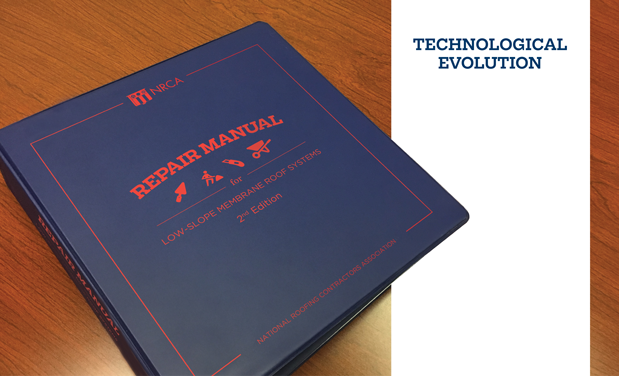3 Bethesda Metro Center is a 17-story commercial office building located above Bethesda Metro Station at the intersection of Wisconsin Avenue and Old Georgetown Road in downtown Bethesda, Md. The tower provides 368,000 square feet of rentable space to tenants and is a hub for major financial institutions such as Merrill Lynch and Bank of America Corp.
Constructed in 1985, the 825,000-square-foot facility includes an impressive 16-story atrium. During the past 30 years, the atrium's composite skylight panels began to delaminate and deteriorate, resulting in significant leaks. The panels were eroding so much, fiberglass was being released and collecting in the building's main gutter.
In 2016, Bethesda Metro Center's atrium skylight system was evaluated for leaks and replaced by Wagner Roofing Co., Hyattsville, Md.
Scope of work
In January 2016, Wagner Roofing began working on the Bethesda Metro Center skylight replacement project. The scope of work involved complete replacement of more than 200 fiberglass panels while reusing the skylights' existing framing system, as well as a complete evaluation and overhaul of the perimeter gutter, flashings and water management systems.
The original 5,500-square-foot skylight system consisted of 205 3-inch-thick insulated fiberglass translucent panels on an extruded aluminum frame that included a two-stage perimeter aluminum gutter system that provided drainage for exterior and interior water to a main built-in gutter at the base of the slope. The main gutter then drained water to internal drains at either end. The same configuration also existed at the base of long rafters that terminated at the built-in gutter. The skylight and gutter systems were tied into the building's exposed aggregate precast concrete cladding panels and the elevator overrun curtainwall at the sides and top.
Throughout its lifespan, the skylight system was repaired multiple times, and the building's original perimeter water management system had been eliminated in an attempt to stop leaks.
Preparation
Accessing the atrium to begin work was a challenge. Wagner Roofing worked closely with Scaffold Resource LLC, Lanham, Md., to engineer a scaffolding system that would enable building operations to remain functional for the project's duration while providing safe, secure access for personnel to work on the skylight and adjacent gutter systems.
"A suspended, tiered platform system made the most sense," says Dean Jagusch, president of Wagner Roofing. "And the existing structure had the means to support it."
The engineered scaffolding system was suspended from the atrium's space frame with webbed beam straps and chains. However, accessing the atrium's underside to install the work platform presented another obstacle. A review of the building's layout provided a solution.
To access the atrium's underside to install the work platform, workers removed one existing skylight panel on the 12th floor and created a temporary "hatch" to transport all material and equipment. This location was strategically chosen because the 12th floor communal balcony area was located about 7 feet below the base of the main built-in gutter and provided safe access for workers. The large area also served as a staging area for materials and debris, but transporting material to and from the area presented Wagner Roofing workers with another challenge.
"Unfortunately, access to the 12th floor balcony was somewhat difficult, so the decision was made to erect a hoist from the loading dock at the street below," Jagusch explains. "This permitted safe and uninterrupted passage of debris and materials without the need to coordinate street closures with three jurisdictions to bring in a crane."
A 160-foot-tall scaffolding system to support the mechanical hoist was erected on the building's exterior and tied to the building's floor slab edges through precast concrete cladding panels.
"Once complete, the suspended scaffolding system provided our workers with safe, sturdy access to the underside of the existing skylight system," Jagusch says. "It also provided far better access for evaluation of the existing framing system and a means to better understand the existing perimeter flashing and water management systems."
To access the center of the skylight's exterior side, workers used extension ladders laid directly on top of the translucent panel system. To ensure workers' safety, fall-protection ropes were attached to anchors in concrete beams at the main roof area above a panoramic elevator curtainwall.
Public safety
Before working on the skylight system, workers protected pedestrians by erecting sidewalk-shedding protection over the building's lobby. Because the building would be fully occupied with heavy pedestrian traffic during the daytime, all interior set-up work was performed at nighttime.
Additionally, a large spiral-shaped wire and metal mobile piece of art was suspended from the skylight's space frame, blocking a majority of the skylight system. As a result, the structure needed to be lowered. To do so, Wagner Roofing enlisted the help of HLT Consulting and Contracting Inc., Baltimore, a specialty rigging and erection firm to perform the work.
"HLT fabricated steel-framed outriggers that connected to two supporting cables on the artwork and lowered the piece 12 feet so it was about 4 feet above the lobby floor for the duration of the project," Jagusch says.
A cable system with debris netting then was installed beneath the skylight panels. The cables enabled the specialty netting to be installed similar to a curtain that was pulled up from the 12th floor to the 16th floor. The netting provided catchment for tools and construction debris that may escape the scaffolding platform system.
Building it
After the scaffolding and netting were securely in place, the Wagner Roofing crew began work on the skylight system. Workers broke down, bagged and transported all tear-off debris to dumpsters via the material hoist.
Working closely with Major Industries Inc., Wausau, Wis., the skylight manufacturer, Wagner Roofing workers carefully pre-measured all existing panels and developed a manufacturing cut list. Because of the atrium's odd shape, nearly 100 skylight panels had to be made in different dimensions. The lower corner panels presented a particular challenge because some had up to six sides with angles that required precise fabrication.
Major Industries provided shop drawings with a custom layout, translucent panels, panel dimensioning, new gaskets and stainless-steel fasteners, as well as new gasketed rafter and purlin caps. As Wagner Roofing workers removed the old skylight panels, they preplaced the new skylight panels with new EPDM gaskets and retainer caps throughout the skylights' interior areas.
The perimeter areas required carefully planned coordination between Wagner Roofing's in-house and on-site skylight installation teams. The odd-shaped perimeter skylight panels were removed in the morning by the on-site skylight crew, exposing the flange of the outer gutter. After the panels were removed, the in-house sheet metal team replaced the outer gutter, allowing enough time for the skylight crew to install the new custom-made translucent skylight panels.
"A high level of communication was paramount to ensure the entire system remained watertight throughout the project," Jagusch says. "We had to plan the timing for each crew to be able to work simultaneously on complex sections in the same day."
After the skylight frame was exposed, the reason for the leaks was discovered. Because the heavily deteriorated skylight panels were well-overdue for replacement, an unusual amount of water had been flowing into the framing system. Consequently, the frame's internal gutter system had become overwhelmed, causing water to back up and overflow into the building's interior.
An improved design
Accordingly, the existing exterior gutter system was removed, and a new two-stage perimeter gutter system was designed to manage exterior rainwater that was fabricated in .063-mil-thick aluminum in Wagner Roofing's sheet metal shop.
"It had become obvious the intricate workings of the skylight's existing water management system had been misunderstood over the years," Jagusch says. "Multiple attempts to repair leaks had only worsened the issue."
To improve waterproofing measures, Wagner Roofing worked closely with Kemper System America Inc., West Seneca, N.Y., the waterproofing membrane manufacturer, and Curtainwall Design Consulting Inc., Dallas, the project's architect, to develop a new liquid-applied reinforced polymer membrane waterproofing system that integrated properly with the adjacent skylight system.
After fabricating the new perimeter gutter, a base waterproofing system of Kemperol 2K-PUR fleece-reinforced liquid membrane was applied in Wagner Roofing's shop before transporting it to the job site where a top coat was applied.
The remaining existing inner aluminum gutter also was prepared and coated with Kemperol 2K-PUR fleece-reinforced liquid membrane in coordination with the removal of adjacent skylight panels.
In addition, workers applied self-adhering Carlisle WIP (water and ice protection) underlayment to the lower main built-in gutter before laying new tapered polyisocyanurate insulation and heat-welding 80-mil-thick TPO membrane.
Workers also designed and fabricated new flashings for the top and bottom sides of the new skylight panels. A single-panel mockup was provided to the building owner for approval before installation.
"This also gave us and the manufacturer the opportunity to ensure the new rubber gaskets, rafter caps, purlin caps and engineered fasteners would work," Jagusch says.
In addition, new custom-fabricated .063-inch-thick bronze anodized aluminum counterflashing was installed to tie the perimeter gutter system into the precast concrete walls, and a new skylight head flashing and expansion system was designed and installed at the interface of the curtainwall system at the elevator enclosure. All custom-fabricated field skylight panels were tied into the new perimeter gutter systems.
Before workers removed all job-site equipment, materials, staging and protection, the new skylight system was tested for water penetration under dynamic pressure in accordance with AAMA (American Architectural Manufacturers Association) 501.1, "Standard Test Method for Water Penetration Of Windows, Curtain Walls and Doors Using Dynamic Pressure."
Metro-ready
About one year later, in February 2017, Wagner Roofing completed its work on Bethesda Metro Center. Working from a suspended scaffolding system, workers successfully replaced the skylight system's composite panels within the existing aluminum frame system, installed a new custom-fabricated gutter system, and applied a newly developed reinforced polymer waterproofing membrane while keeping occupants safe and without any disruptions to building operations. The result is a new water management system with no leaks and greatly improved building aesthetics.
"It was satisfying to plan out all the intricacies of the entire project and then see it all come together through exceptional communication and coordination throughout our team," Jagusch says.
For exceptional preparation and outstanding work on Bethesda Metro Center, Wagner Roofing received a 2018 Gold Circle Award in the Innovation Solutions (Reroofing) category and a 2018 Safety Preparedness and Performance award from The Roofing Industry Alliance for Progress.
Project name: Bethesda Metro Center
Project location: Bethesda, Md.
Project duration: January 2016-February 2017
Roof system type: Skylight panel system replacement
Roofing contractor: Wagner Roofing Co., Hyattsville, Md.
Roofing manufacturers: Carlisle WIP Products, Carlisle, Pa.; Kemper System America Inc., West Seneca, N.Y.; Major
Industries Inc., Wausau, Wis.



